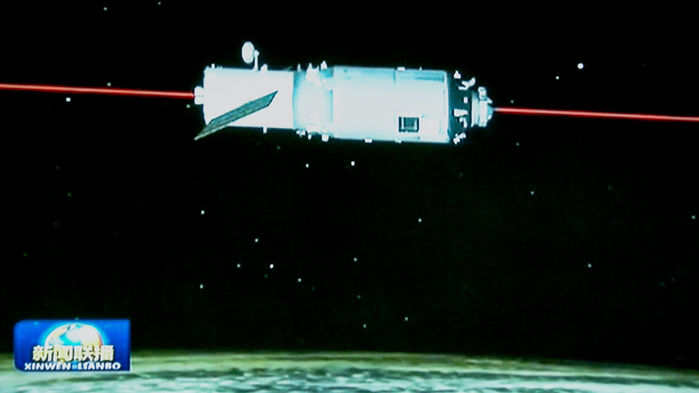Clocks that use cold atoms form the backbone of the international time system here on Earth. Now, scientists in China have successfully demonstrated a cold atom clock in space, an achievement that could lead to more accurate terrestrial timekeeping and better tests of fundamental physics.
Most atomic clocks rely on a very steady tick: the frequency of fluorescent light emitted by cesium atoms after being excited by a microwave field. The frequency is steadier when the atoms move slowly, and so scientists first trap the atoms using intersecting laser beams and cool them down to a few millionths of a degree above absolute zero.
Because the laser beams would impair the frequency measurement, the atoms must be released from the trap before they are excited by the microwaves. Typically, they are nudged upward by another laser and zapped with microwaves as they rise and then fall back down to Earth. But the briefness of this free fall limits how long the atoms can be probed and, hence, the clock’s accuracy and stability. In orbit, however, the atoms are in continuous free fall and can in principle be probed over longer periods of time.
The Cold Atom Clock Experiment in Space (CACES) involves trapping, cooling, and probing rubidium atoms within a box that could fit in the trunk of a car. In orbit at an altitude of 400 kilometers, the experiment was launched on board China’s Tiangong-2 space laboratory last September. Now, a year later, it is performing just as expected, according to a paper posted to the arXiv server by scientists at the Chinese Academy of Sciences’s Shanghai Institute of Optics and Fine Mechanics.
Shanghai team leader Liang Liu says that he and his colleagues “had to work night and day” to get CACES ready for launch. They “encountered tremendous technical difficulties,” he recalls, in shrinking the bulky and complex equipment needed to trap and cool atoms and also ensuring that the kit withstands the rigors of space. “Fortunately we did it, and after a year in orbit CACES is still working perfectly,” he says.
As such, Liu and co-workers have overtaken scientists working on a mission for the European Space Agency known as the Atomic Clock Ensemble in Space (ACES). Proposed in 1997, ACES has faced a series of funding and technical delays that mean it won’t arrive at the International Space Station for at least another year. In contrast, CACES has gone from conception to operation in just a decade.
The Chinese clock, however, is less advanced than its European counterpart, which will use cold cesium atoms. For one thing, its estimated stability—three parts in 1013—is a third of ACES design value, meaning it would take nine times as long to reach a given accuracy. In addition, CACES doesn’t transmit its ticking to Earth, so its accuracy can’t be regularly monitored. (It has a data link but not one that can send stable time and frequency information.) ACES, on the other hand, will communicate its timekeeping to Earth through a microwave link, allowing atomic clocks on the ground to be calibrated and also enabling tests of the theory of general relativity involving the effect of altitude on a clock’s ticking rate.
ACES Principal Investigator Christophe Salomon, an atomic physicist at the Ecole Normale Supérieure in Paris, says that although Liu and colleagues have demonstrated the basics of a cold atom clock in orbit, they haven’t fully exploited that capability—the longest recorded time measurement was actually shorter than the 0.5 seconds typically reached on Earth. “They have made a nice technology demonstration,” he says, “but it is disappointing that they haven’t taken advantage of the microgravity.”
Stephan Schiller, an atomic physicist at the University of Düsseldorf in Germany, points out that, strictly speaking, CACES is not the first cold atom experiment to be carried out in space. In January, German researchers produced an exotic state of matter known as a Bose-Einstein condensate by launching cold atoms on a sounding rocket from Sweden. But that flight lasted just 6 minutes—“a different ball park” to a year of tests, he maintains. “With their experiment,” he says, “the Chinese are at the forefront of space-based cold atom sensors worldwide.”
Next, Liu and colleagues plan to install a more stable clock with links to the ground on board China’s space station, which is due to start taking shape in 2020. Then both they and a group of European researchers led by Schiller aim to test orbital “optical clocks,” which would use a laser beam to probe atoms with higher frequency emissions in order to generate even more precise ticks than a microwave device. “There is an exciting future for high-precision clocks in space,” Schiller says.(Science)
